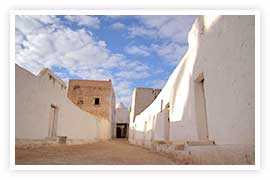The Sahara
Ghadames
 Ghadames has hosted successive cultures since pre-history. Its name was well known to the ancients. Later, Ghadames participated in the spread of Islamic culture into the regions of south of the Sahara. This was facilitated by the caravan trade, which continued until the twentieth century. Ghadames has hosted successive cultures since pre-history. Its name was well known to the ancients. Later, Ghadames participated in the spread of Islamic culture into the regions of south of the Sahara. This was facilitated by the caravan trade, which continued until the twentieth century.
Built in the desert, Ghadames remains an outstanding example of a traditional settlement. It is known as "the pearl of the desert" thanks to its unique domestic architecture. Each storey of the houses is assigned a different function: the ground floor is storage, above which lies a system of passageways, and on the top open aired terraces reserved for women. The houses of Ghadames are perhaps better known for the distinctive red and white decoration of their interiors and the sensuous lines of their mud-brick exteriors.
Ghirza
 Ghirza is located in the pre-desert south east of Tripoli and about 120 km from the coast of the Gulf of Sirte. At the beginning of the Second Century AD, this area was brought into the Roman Empire. The African Legion of the Roman army was called in to deal with the independent tribes of Ghadames and other southern areas. The requirement to pay Roman taxes and provide supplies to the army probably stimulated the pre-desert economy. Ghirza is located in the pre-desert south east of Tripoli and about 120 km from the coast of the Gulf of Sirte. At the beginning of the Second Century AD, this area was brought into the Roman Empire. The African Legion of the Roman army was called in to deal with the independent tribes of Ghadames and other southern areas. The requirement to pay Roman taxes and provide supplies to the army probably stimulated the pre-desert economy.
During the Fourth Century under Diocletian, the province of Tripolitania, extended from the Chott Jerid salt lake in present Tunisia to neighboring Cyrenaica. Roman laws provided for the integration of indigenous tribal people into the Empire. In the first half of the fourth century, Ghirza enjoyed remarkable prosperity and its leading families were in close contact with the urban areas of the coast. At the same time, the distinctive qualities of Punic, Libyan and Numidian cultures remained in Ghirza's architecture and writing.
First excavated in the 1950's, Ghirza offers a large collection of Romano-Libyan remains in a striking wilderness setting. There are fourteen monumental tower and temple tombs in the region. Ghirza has two types of temple tombs: those with collonades colonnades and those with an arcaded portico. The largest is in the form of a classical temple steps leading to the podium, intricate friezes with animal sculpture, inscriptions in Latino-Libyan and upper and lower funerary chambers.
Many of Ghirza's houses were multi-storey fortresses, often with courtyards, cisterns and towers. These may have been built for veteran soldiers by the Roman authorities. These fortified farms were similar to structures still seen in the Mediterranean, where animals were kept on the ground floor, the family lived on the next level and fodder and grain were stored on the top floor.
 Ghat Ghat
Situated in the far southwestern corner of Libya, Ghat is known to the Touareg as the Land of Peace. The town was established during the First Century on the ruins of Rana. From the Fourteenth century it was known as Ghat and it has since then appeared in the works of numerous early travelers and geographers. Today, its remains bear witness to a prosperous ancient city. In the surrounding areas, there are fine examples of prehistoric cave art.
Nalut
The desert town of Nalut near Libya's border with Tunisia has a multi storey granary and many other examples of traditional architecture.
Germa
 Germa was the center of the Garamantean culture. The first tribes settled on the Zinkikra mountain, where important ancient remains are found. The town thrived as the inhabitants controlled trade routes from the Mediterranean to the Sahara. Germa was the center of the Garamantean culture. The first tribes settled on the Zinkikra mountain, where important ancient remains are found. The town thrived as the inhabitants controlled trade routes from the Mediterranean to the Sahara.
The Libyan Garamante tribe settled the Fezzan region on Zinkikra Mountain. They practiced agriculture and had oxen that were at the back of the pasture because of their enormous horns. The tribe dominated the Sahara and their chariots reached Ghadames. Tassili Hagar, the heights of Idrar and the border of Niger. The Grarmantes also practiced elephant and ostrich hunting and were brave warriors who knew no fear.
Herodotus, Book IV
The oval city stretches over 5 km from east to west and 3.5km from north to south. Its remains include the mausoleum of Uatut, cemeteries, mosques, a circular fort with three towers, and the wall with three gates.
Matandush
Matandush in the extreme South of Libya is the site of outstanding rock carvings from pre-history.
| 5000 BC |
First evidence of Garamantes culture |
| 790 BC |
Ghadames, then known as Idamus, occupied by Carthage |
| 2nd c AD |
Ghirza is integrated into the Roman Empire |
| 3rd c AD |
Province of Tripolitania encompasses the Libyan heartland |
| 7th c |
Okba bin Nafaa brings Islam to the area |
| 1986 |
Ghadames listed as a UNESCO World Heritage Site |
|

